This is the last of 3 related postings regarding Auschwitz. The first post is available here and the second here.
The last selection took place on October 30, 1944. In September Heinrich Himmler, Reichsführer of the SS, ordered the crematoria destroyed before the advancing Soviet Army reached the camp. The gas chambers of Birkenau were blown up by the SS in January 1945 in an attempt to hide their crimes.
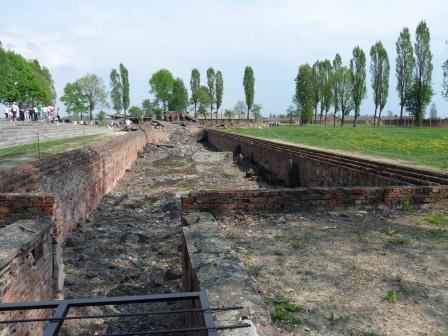
The SS command sent orders on January 17, 1945 calling for the execution of all prisoners remaining in the camp, but in the chaos of the Nazi retreat the order was never carried out. They did try to evacuate the camp though. Nearly 60,000 prisoners were forced on a death march toward a camp in Wodzisław Śląski, over 60 kilometers away. Many never made it. On January 27, 1945, Auschwitz was liberated by Soviet troops.
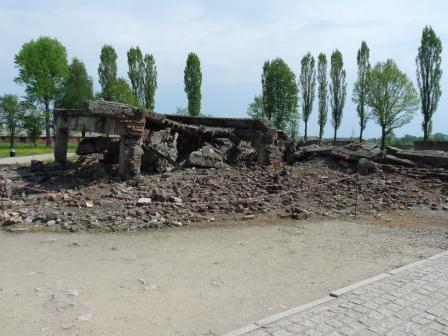
On November 24, 1947, the Polish Supreme National Tribunal in Krakow began the trial of only 41 of the over 6,000 Nazis who worked at Auschwitz. It took less than a month. 23 death sentences were issued, as well as 16 imprisonments. Commandant Höss was found hiding among the German civilian population. He was tried, found guilty of numerous war crimes, and then hung on a gallows specifically erected for this purpose, in a place just between the home he shared with his wife and children and the first gas chamber at Auschwitz I.
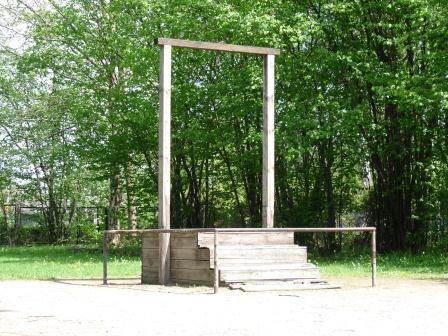
Visiting the Memorial
In 1947, Poland founded a museum on the site of Auschwitz I and II. It receives about 1.3 Million visitors annually. Why do they come? Why did I come? I had already been to see 2 other concentration camps in Germany, Dachau and Buchenwald.
Visitors to Auschwitz I are required to go on a guided tour. It includes the grounds, several of the barracks (including Block 11), and the first gas chamber and crematorium. Particularly shocking are the exhibitions showing the confiscated belongings of inmates found by the Soviet liberators. These include hundreds of eye glasses in a tangled pile, thousands of pairs of shoes, a room full of prosthetic limbs, a huge pile of suitcases (many with the names of their owners written on the sides), a 30 meter (98 ft.) long room filled with 2 tonnes of human hair, and nearby a display of the products made from this hair.
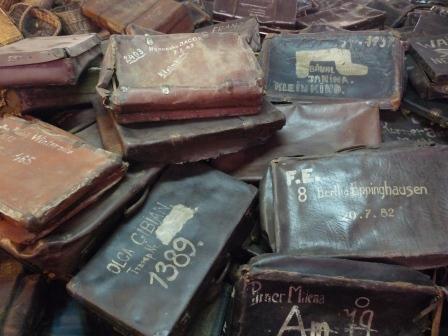
Some of the prosthetic limbs were from German Jews, veterans of World War I who fought for their country, only to be killed by the Nazis 25 years later. We also saw baby clothes and dolls of some children murdered here. These items really brought home the humanity of the victims. They were not just statistics, but real people just like us, who had children to be consoled, who wore shoes and who needed glasses.
While visiting we observed several other groups that were obviously Jewish. We saw a group of Israeli military with the Star of David on their uniforms and a group of young men in black dress pants and white shirts wearing yamikas who were accompanied by a rabbi. I wondered how many Jewish people are drawn to this place, to see what happened here. How surreal must this be for them. Notably, the signs at Birkenau II are in Polish, English, and in Hebrew.
There were many more visitors here than when we went to Dachau or Buchenwald, partly because it was a week with 2 national holidays, a week when many Poles take time off work. When we arrived, there were touts trying to direct cars and buses to their private parking areas. The staging area where people purchased tickets and waited for their guides was crowded and loud, too busy to encourage self-reflection at the start of the tour. After this point, all visitors to Auschwitz I wear headsets to hear their guides’ voices transmitted wirelessly. The barracks were similarly crowded with visitors, and the logistics of keeping our group together and on pace was distracting. The whole thing had a feeling of mass-production. For me, I could begin to reflect upon things only when we reached the quieter, open spaces of Auschwitz II-Birkenau.
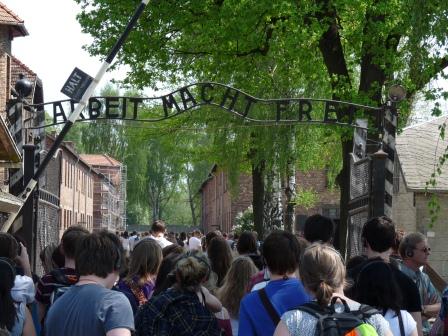
The guide’s narrative was fast-paced and direct. He did not pull any punches, rely on subtle differentiations, or utilize any euphemisms. This surprised me because there were some young children in our group. I wondered how many of them really understood what he was talking about.
Why did I visit another camp? Perhaps because Auschwitz was different. It was an extermination camp, the largest and the most infamous. Why did I want to visit it? Certainly not because my wife wanted to. She went only at my request. Perhaps it’s because I still can’t get my head around it. I understand something of Nazi doctrine and how many Germans were seduced by it. Hitler told them they were special, that he could fix their problems quickly, and he offered them someone else to blame. I’ve studied the research that demonstrates that ordinary people can and will do terrible things to one another with the slightest institutional inducement. The German people were not evil nor special in this regard. Most of them didn’t know what was happening in the extermination camps. The whole thing just seems so surreal to me. The huge numbers of people killed make it hard to conceptualize. The horrific acts almost impossible to imagine.
Today the confines of Auschwitz II-Birkenau are green and grassy. It is surrounded by birch trees. When we visited, the sun was shining, the birds were singing, and there was a warm breeze. This made it difficult to visualize what happened here. Of course, when the camp was operational, there was no grass, only mud, due to the large numbers of prisoners occupying the space.

For all these reasons, I found my trip to Auschwitz to be less emotional than my previous visits to other concentration camp sites in Germany. Perhaps it’s a coping mechanism to allow the contemplation of such atrocities?
Auschwitz is a place where murder took place on an industrial scale with the goal of eliminating an entire race of people. The scariest and saddest thing is that, albeit with cruder methods, similar things have happened since in other places (e.g. Cambodia, Rwanda, Bosnia, Sudan). Will we ever evolve to the point where such atrocities don’t happen?
This is the last of 3 related postings about Auschwitz. The first post is available here and the second here.
One thought on “Auschwitz III”